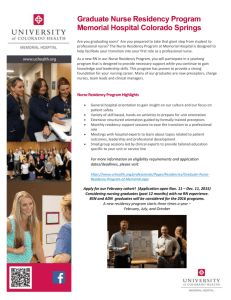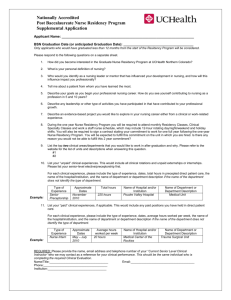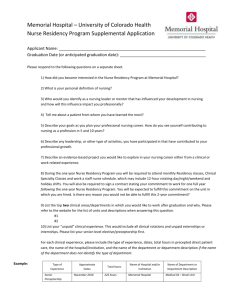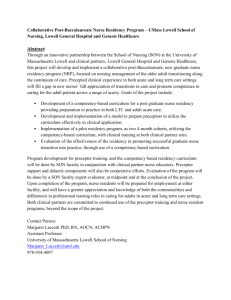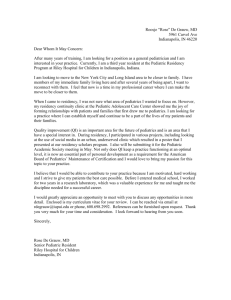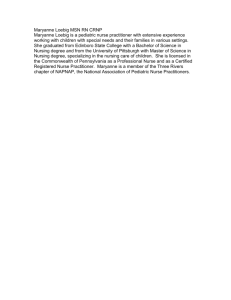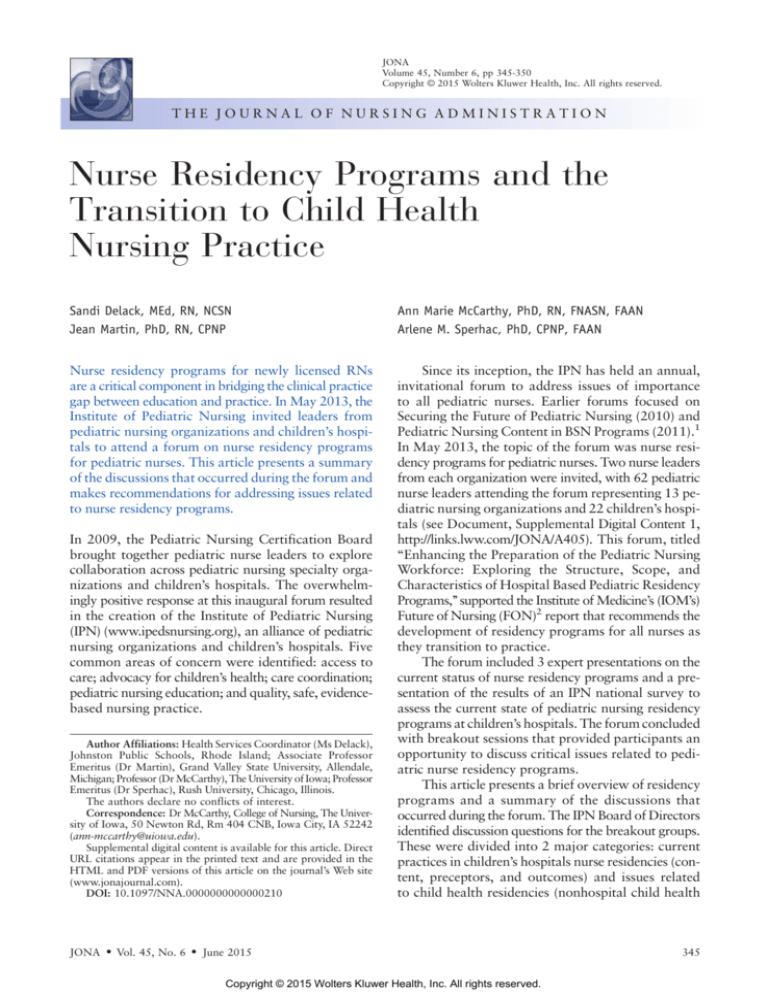
JONA
Volume 45, Number 6, pp 345-350
Copyright B 2015 Wolters Kluwer Health, Inc. All rights reserved.
THE JOURNAL OF NURSING ADMINISTRATION
Nurse Residency Programs and the
Transition to Child Health
Nursing Practice
Sandi Delack, MEd, RN, NCSN
Jean Martin, PhD, RN, CPNP
Ann Marie McCarthy, PhD, RN, FNASN, FAAN
Arlene M. Sperhac, PhD, CPNP, FAAN
Nurse residency programs for newly licensed RNs
are a critical component in bridging the clinical practice
gap between education and practice. In May 2013, the
Institute of Pediatric Nursing invited leaders from
pediatric nursing organizations and children’s hospitals to attend a forum on nurse residency programs
for pediatric nurses. This article presents a summary
of the discussions that occurred during the forum and
makes recommendations for addressing issues related
to nurse residency programs.
Since its inception, the IPN has held an annual,
invitational forum to address issues of importance
to all pediatric nurses. Earlier forums focused on
Securing the Future of Pediatric Nursing (2010) and
Pediatric Nursing Content in BSN Programs (2011).1
In May 2013, the topic of the forum was nurse residency programs for pediatric nurses. Two nurse leaders
from each organization were invited, with 62 pediatric
nurse leaders attending the forum representing 13 pediatric nursing organizations and 22 children’s hospitals (see Document, Supplemental Digital Content 1,
http://links.lww.com/JONA/A405). This forum, titled
‘‘Enhancing the Preparation of the Pediatric Nursing
Workforce: Exploring the Structure, Scope, and
Characteristics of Hospital Based Pediatric Residency
Programs,’’ supported the Institute of Medicine’s (IOM’s)
Future of Nursing (FON)2 report that recommends the
development of residency programs for all nurses as
they transition to practice.
The forum included 3 expert presentations on the
current status of nurse residency programs and a presentation of the results of an IPN national survey to
assess the current state of pediatric nursing residency
programs at children’s hospitals. The forum concluded
with breakout sessions that provided participants an
opportunity to discuss critical issues related to pediatric nurse residency programs.
This article presents a brief overview of residency
programs and a summary of the discussions that
occurred during the forum. The IPN Board of Directors
identified discussion questions for the breakout groups.
These were divided into 2 major categories: current
practices in children’s hospitals nurse residencies (content, preceptors, and outcomes) and issues related
to child health residencies (nonhospital child health
In 2009, the Pediatric Nursing Certification Board
brought together pediatric nurse leaders to explore
collaboration across pediatric nursing specialty organizations and children’s hospitals. The overwhelmingly positive response at this inaugural forum resulted
in the creation of the Institute of Pediatric Nursing
(IPN) (www.ipedsnursing.org), an alliance of pediatric
nursing organizations and children’s hospitals. Five
common areas of concern were identified: access to
care; advocacy for children’s health; care coordination;
pediatric nursing education; and quality, safe, evidencebased nursing practice.
Author Affiliations: Health Services Coordinator (Ms Delack),
Johnston Public Schools, Rhode Island; Associate Professor
Emeritus (Dr Martin), Grand Valley State University, Allendale,
Michigan; Professor (Dr McCarthy), The University of Iowa; Professor
Emeritus (Dr Sperhac), Rush University, Chicago, Illinois.
The authors declare no conflicts of interest.
Correspondence: Dr McCarthy, College of Nursing, The University of Iowa, 50 Newton Rd, Rm 404 CNB, Iowa City, IA 52242
(ann-mccarthy@uiowa.edu).
Supplemental digital content is available for this article. Direct
URL citations appear in the printed text and are provided in the
HTML and PDF versions of this article on the journal’s Web site
(www.jonajournal.com).
DOI: 10.1097/NNA.0000000000000210
JONA Vol. 45, No. 6 June 2015
Copyright © 2015 Wolters Kluwer Health, Inc. All rights reserved.
345
residency programs including the role of specialty
organizations in nurse residency programs). At the
forum, each group consisted of participants from children’s hospitals, pediatric nursing organizations, and a
facilitator from the IPN Board. Summaries of the
discussions were presented to the total group. Following the forum, the participants of each group were sent
the summary of the discussion they participated in for
verification and further comment.
Overview: Nurse Residency Programs
There is a continental divide between nursing education and nursing practice,3 with a need to bridge the
educational preparation to clinical practice gap of the
newly licensed RN (NLRN). To address this issue,
The Joint Commission recommends standardized postgraduate nurse residency programs.3 In support of
this recommendation, the Robert Wood Johnson Foundation and the IOM compiled evidence and, as part
of the FON, urged the development of formal residency education programs to reduce turnover rates and
strengthen nursing knowledge and skills in support
of quality patient care.2 The formalized instruction
and socialization provided in residency programs extend beyond orientation and are individualized to assist
NLRNs to expand their clinical skills and leadership
competencies beyond entry-level nursing practice. The
formal curriculum provides guided experiences with
preceptors, didactic content and clinical skills, debriefing and self-care sessions, and formal mentoring.
NLRNs face many transition challenges including colliding expectations between their beliefs and
the experiences they are having, pressure to function
as RNs by managing patient care and autonomous
decision making, workplace demands such as a high
nurse-to-patient ratio, and lack of respect often with
uncivil work environments.4-6 A description of nurse
reality shock4 documented that the learning needs of
NLRNs extend beyond the academic setting and that
growth from novice to expert can occur through additional postacademic education and practice experiences.7
Residency programs benefit NLRNs by helping
to bridge the transition to practice and may benefit
the organization by improving patient outcomes through
establishment of a culture of healthy clinical nurse
practice environments and retention.6 NLRNs who
completed programs were more confident, more likely
to be patient advocates, linked critical thinking with
actions, used evidence-based practice (EBP), and displayed enhanced communication and leadership skills.8
At 12 months, NLRNs who participated in residency
programs had increased confidence, skills, and abilities, and their turnover was one-third of the national
average.9,10 A reduction in environmental reality shock,
346
an increase in job and practice satisfaction, and improved performance were noted.11 An overall commitment to the profession and to the organization,
appreciation of the rhythm in the chaos of the unit,
and a feeling of being valued were other outcomes.12
Hendren13 reported that the return on investment in
nurse residency programs was realized in the greater
competency and retention of the NLRN.
Current Practices in Children’s Hospital:
Nurse Residencies
What content is critical and unique for inclusion in a
pediatric nursing residency program?
The participants discussed general issues followed
by pediatric-specific content that should be included
in all nurse residency programs in children’s hospitals.
The identified specific content areas included professionalism, family-centered care, clinical competence,
leadership, informatics, communication, and work-life
balance. Under each topic, key elements were discussed.
General Issues
The group felt that the complexity of pediatric care
and the increased expectations of nurses make it difficult for NLRNs to function effectively unless they
are fully prepared to assume their role. The NLRNs
have had limited time and experience during their
undergraduate education to synthesize and apply the
knowledge and skills that they have learned in the
classroom, particularly in specialties such as pediatrics.
Pediatric didactic content in a classroom or through
clinical conferences and debriefing sessions is critically needed, in addition to having defined, focused,
clinical pediatric experiences with preceptors.
There was unanimous agreement that a residency
program needs to be individualized with objectives
tailored to meet the needs of new nurses. Because
academic programs frequently provide little or no
pediatric clinical experience, an assessment of NLRN
knowledge and skills is required to provide a meaningful and individualized pediatric-focused program.
Academic programs meet required standards and the
essentials of nursing education, so all graduates have
a theoretical basis for care. However, NLRNs in hospital settings must develop clinical reasoning, competence, and the confidence needed to provide safe,
quality, evidence-based care for children.
Professionalism
Participants thought that patient advocacy, interprofessional education, teamwork, EBP, and quality improvement (QI) initiatives are important topics for
all NLRNs. Many programs require an EBP or QI
project. Understanding ethical principles, the scope
JONA Vol. 45, No. 6 June 2015
Copyright © 2015 Wolters Kluwer Health, Inc. All rights reserved.
and standards of nursing practice as well as professional boundaries and the roles of other team members are essential topics.
Family-Centered Care
Families may be of diverse cultures and social backgrounds, so awareness of various individual and group
values and beliefs is important. Content should include
current patient and family care needs and plans for
future care, including palliative and end-of-life care.
The participants believed that family-centered care is
critical knowledge.
Content for Clinical Competence
To gain clinical competence, the group discussed the
need for both didactic classes and clinical experiences.
Didactic content on topics specific to children such as
growth and development, assessment, medication management, technical skills, anticipatory guidance, and
family counseling is needed. Pediatric pain management and palliative care should also be included. Classes
should contain content on the unique needs of the
pediatric patient and their family.
The group felt that individualized residency programs should include clinical experience on both the
NRLN’s assigned unit and varied experiences with
a preceptor(s) on other units, such as the emergency
department. This experience would provide NLRNs
with a more comprehensive understanding of the importance of coordinating care within the organization.
Coordinating Care: Communication, Leadership,
and Data Management
Participants felt strongly that NLRNs require support
to acquire the skills to communicate clearly in written,
verbal, and nonverbal forms. There is an expectation
that nurses coordinate the care of their patients, so
NLRNs need training to be competent in this role and
confident in their abilities. Learning to be a supportive
team member, helping to develop others, delegating
when appropriate, and eventually leading a team are
leadership skills to be developed. Coordinating and
monitoring patient care require an understanding of
what data are meaningful, documenting findings through
appropriate use of electronic health records and informatics, and presenting data that contribute to care
coordination and QI.
Lifelong Learning
The group believed that to maintain clinical competence, lifelong learning should be presented as an expectation, starting with the residency program. Multiple
strategies benefiting both the NLRN and the organization included interprofessional experiences, participating in organizational councils, learning preceptor
skills, and developing an evidence-based or QI project
that may be presented at regional and national conferences. Organizations supported lifelong learning
by providing resources such as continuing education
programs, research and academic opportunities, and
affiliations that encourage nurses to continue formal
education.
Work-Life Balance
Given that a large number of nurses leave the profession in the 1st year of practice, the group agreed
that it is essential that content on work-life balance
be included. As noted earlier, new nurses deal with
reality shock4 and sometimes with an unrealistic expectation that they must move quickly from novice
to expert. Providing time for self-reflection and learning stress management techniques and strategies for
personal and professional time management are needed
to help NLRNs with the transition.
Preceptors
What are the best strategies for residency preceptor
selection, education, recognition, burnout prevention,
and evaluation?
Participants noted that 1 of the most challenging
issues for residency programs is preceptors. The group
initially identified issues related to the selection, training, recognition, burnout prevention, and evaluation
of preceptors and then identified strategies to address
these issues. Some of the recommendations had been
tried or used successfully at participants’ organizations.
Following is a summary of the group’s discussion relative to the issues they identified related to preceptors.
Selection of Preceptors
The role of the preceptor is not clearly or consistently
defined in terms of competencies, qualifications, and
expectations. The selection methods for preceptors
vary from volunteer, to an application process, to an
organizational requirement. There is a need to differentiate between basic and advanced precepting to meet
the needs of student nurses and NLRNs. Challenges to
maintaining a successful preceptorship program include addressing competing time demands on preceptors, scheduling consistent preceptors, and meeting
the increased demand for preceptors with staff growth
or vacancies.
The role and qualifications of the preceptor need
to be clearly articulated to staff nurses through informational workshops. Subsequently, an application process allows for a more objective selection of qualified
preceptors based on established criteria rather than
making precepting mandatory for all nurses. Unitbased preceptor committees responsible for reviewing
applications promote ownership of the program by
JONA Vol. 45, No. 6 June 2015
Copyright © 2015 Wolters Kluwer Health, Inc. All rights reserved.
347
staff. Letters of recommendation from peers and a
manager describe the experience and performance
levels of potential preceptors. Matching preceptors
to NLRNs is an important aspect of the selection process and can be achieved through an interview process
of both potential preceptors and the NLRN.
Education for Preceptors
According to the participants, preceptors need education in specific areas to support their ability to
precept NLRNs. They must understand principles of
adult learning and a range of teaching methods and
may require training in conflict resolution. Furthermore, preceptors need ongoing education to meet the
emerging needs of NLRNs. Approaches to educating
preceptors may include social media, a Web page, and
a newsletter. Conducting an annual assessment of preceptors’ needs provides the opportunity to offer workshops that address topics such as family-centered care,
QI, safety, and leadership. Whether the education and
training of preceptors are generalized or unit based, a
preceptor committee as part of the nursing governance
structure is recommended. The availability of a clinical educator who is dedicated to half-time on the unit
and half-time in continuing education can model behavior as well as oversee the unit preceptors.
Recognition of Preceptors
The group felt it is extremely important to recognize
preceptors for their invaluable role. Recognition can
be financial, clinical, or professional recognition. Some
institutions provided a pay differential or bonuses.
Clinical recognition can be assignments that prioritize the learning needs of the NLRN and through the
clinical ladder. Professional recognition was common
at most institutions and included a letter of recognition for the preceptor’s file and support for obtaining
national preceptor certification. Preceptors can be recognized during a luncheon that could include awards
such as Preceptor of the Year (unit based or organizationally), as well as with gifts and thank-you notes
from the precepted nurse residents.
Burnout Prevention
The participants felt that burnout is a real threat to
preceptor satisfaction and success. Two examples to
decrease the burden on the preceptor were a bootcampYlike experience for the NLRN to introduce daily
skills and scheduling time periodically with a clinical
educator for such things as safety checks and rounds.
Using simulation for the NLRN to hone clinical skills
frees the preceptor during the busy clinical day. Minimizing floating while precepting and a contingency
plan for the NLRN to engage in independent learning when the preceptor must be pulled into an emer-
348
gency situation reduce conflict in role expectations.
Team precepting and planned breaks from precepting
can reduce burnout among preceptors.
Evaluation
Evaluation of preceptors is essential to ensure expectations and standards are being met, to document the
NLRN is receiving the needed experiences, and to
provide guidance and direction for preceptors. One
method identified by the group is the 360-degree
evaluation, where the preceptor, NLRN nurse residents, clinical manager, and clinical educator all evaluate the preceptor based on established criteria. The
evaluation method selected should fit in the overall
evaluation of the nurse residency program.
Outcomes
What are the outcomes of residency programs? How
should a residency program be evaluated?
Participants identified 2 areas that need to be addressed by residency programs: those outcomes related
to the individual and those related to the organization.
In addition, discussion focused on what evaluation
instruments should be used.
Individual
The goal of residency programs is to provide additional educational experiences that assist a nurse in
the transition from student to novice. This group began
by discussing areas of core content and the need to
identify the expected outcomes for the NLRN. Embedded in programs are evaluations of the NLRN’s knowledge of critical information. Skill demonstrations on
designated units or through simulation are often included as measures of progress within the program.
One outcome measure of residency graduate knowledge acquisition that some participants cited as important to their residency program is attainment of
certification as a pediatric nurse. The most frequently
cited evaluation tool used by these participants in their
residency programs is the Casey-Fink Graduate Nurse
Experience Survey.14 The Casey-Fink includes multiple sections that address skills, job satisfaction, transition difficulties and supports, and stressors. The scale
takes approximately 15 to 20 minutes to complete and
is not specific to pediatric nursing or children’s hospitals. Programs typically have residents complete the
Casey-Fink at the beginning of the program, at 6 months,
and at 1 year, for yearlong programs.
Organizational
For many organizations, the impetus for supporting a
residency program is the impact it has on workforce
factors, such as retention rates of staff nurses and
related vacancy rates. Participants stated that their
JONA Vol. 45, No. 6 June 2015
Copyright © 2015 Wolters Kluwer Health, Inc. All rights reserved.
program maintains data on employment trends and
retention rates and monitors trends over multiple years.
Issues Related to Child Health Residencies
Nonhospital Child Health Residency Programs
How do we address the need for residency programs
for nurses in nonhospital settings?
Although most residency programs have focused
on hospital patient care settings, it is critical that residency programs outside acute care settings be developed and evaluated. Currently, 38% of nurses are not
employed by hospitals.2 However, the shift of care
from acute care institutions to the community as well
as changing demographics require residency programs
be developed to prepare nurses for these roles as well.
Developing effective models for nurse residencies
in nonhospital settings presents additional challenges.
The group felt that structure, funding, and quality are
a few of those challenges. Pediatric nurses practicing
in schools, home care, and private practice settings are
often more isolated and have less opportunity to benefit
from the knowledge and skills of more seasoned practitioners. Creative models that differ from hospital
pediatric nurse residency programs will need to be
explored.
Funding is a major challenge to developing residencies for nurses practicing in these settings. There
is often no organizational support or resources to develop and maintain nurse residency programs. Securing
grant funding for a pilot program that demonstrates
successful outcomes would set the stage for obtaining
organizational partnerships and additional funding.
Community settings that employ pediatric nurses
typically do so in small numbers. On-line programs
are a way to bring community based nurses together
to create a residency program. Synergy could be created
through Listserv, social networking, and video conferencing, with the option of interspersed face-to-face
meetings. Collaboration among these smaller organizations to create nurse residency opportunities may be
a cost-effective and realistic way to design effective
programs. These strategies would be particularly effective in rural areas where there are few experienced
staff to serve as preceptors. An example of a successful model is the collaboration between the Association of Montana Healthcare Providers and Idaho
State University’s North West Rural Nurse Residency
Program to assist Montana hospitals with developing
transition to practice programs.15 The group also believed that developing regional partnerships among
providers is another option to create pediatric nurse
residencies in the community. State departments of
health may potentially develop programs for multiple
nursing roles transitioning into practice, incorporating
the expertise of intradisciplinary and interdisciplinary
groups. For example, pediatric nurse practitioners
could collaborate with school nurses to provide asthma
education and mentorship.
Despite the recognition that residency programs
outside acute care settings are needed, there are few
examples of residency programs for new APRNs or
nurses changing practice sites or specialties.16-18 Recommendation 3 of the IOM report2 endorses participation in nurse residency programs after completion
of an advanced practice degree program or prelicensure
program or when transitioning into a new clinical
practice area.
Specialty Organizations and Nurse Residency Programs
How can specialty pediatric nursing organizations support or contribute to the success of nursing residency
programs?
The group felt that specialty organizations and
residency programs could create a global vision for
participants by sharing educational resources and
content. They also saw it as an opportunity to build
leadership skills and solidify a commitment to professional nursing organizations. Pediatric nursing specialty organizations could offer discounted conference
fees to residents, free continuing education, and coordinate delivery of presentations on various topics to
residents. In return, specialty nursing organizations
would have an opportunity to promote student membership, expand their new graduate’s membership numbers, and involve residents in chapter committees.
The group explored the possibility of developing
future leaders of pediatric specialty organizations through
involvement with the pediatric nursing residency programs. Overall, the group felt that building relationships between pediatric nurse residency programs and
local chapters of specialty organizations would provide unique benefits to both groups.
Conclusions
This article has presented findings from the 2013 IPN
forum on nurse residency programs for pediatric
nurses. Although the importance of nurse residencies
is well established, there remains a need for articulating the essential components of these programs.
Breakout sessions at the forum focused on content,
preceptors, outcomes, how to address the need for
residency programs in nonhospital settings, and the
role of pediatric nursing professional organizations in
residency programs. Key themes emerged from the discussion for each of the components and are summarized in Table 1.
Evaluation of residency programs overall has been
difficult for many reasons, the main one being the wide
JONA Vol. 45, No. 6 June 2015
Copyright © 2015 Wolters Kluwer Health, Inc. All rights reserved.
349
Table 1. Recommendations for Essential Components of Pediatric Nurse Residency Programs
Course Content Needed
&
&
&
&
&
&
&
&
&
Clinical competence
Communication
Coordinating care
Data management
Family-centered care
Leadership
Lifelong learning
Professionalism
Work-life balance
Preceptor Needs and Resources
&
&
&
&
&
Administrative Responsibility
Burnout prevention
Education
Evaluation
Recognition
Selection
&
&
&
&
variation in content and in the teaching and learning
strategies used. As a major nursing education redesign,
residency programs could be used to test the principles,
concepts, and strategies of organizational transformation and of experiential-interactive learning.19 To
demonstrate the outcomes and the effectiveness of
these programs, well-designed quasi-experimental studies are needed.
The comments and suggestions from the discussion groups were not unexpected. However, the frequency with which themes emerged underscores the
need for developing nurse residency programs for
NLRNs in which content, selection, education of preceptors, and outcome evaluation are consistent across
programs. In addition, developing programs to meet
Assess individual and organizational outcomes
Determine cost
Evaluate use of technology
Identify opportunities for collaboration and education
the needs of nurses in nonhospital settings and the role
of specialty organizations needs to be addressed.
The need for nurse residency programs for NLRNs
that are well designed and effectively implemented
is evident, and the value of these programs has been
demonstrated. The challenge ahead is to establish standards to ensure consistency across programs and the
ability to evaluate outcomes in order to ensure safe,
high-quality nursing care.
Acknowledgment
The authors thank the Pediatric Nursing Certification
Board for the support they have provided to the Institute
of Pediatric Nursing, the annual forums, and this article.
References
1. McCarthy AM, Wyatt J. Issues and challenges in undergraduate
pediatric nursing education. J Prof Nurs. 2014;30(2):130-138.
2. Institute of Medicine. The Future of Nursing: Leading Change,
Advancing Health. Washington, DC: The National Academies
Press; 2011.
3. Joint Commission on Accreditation of Healthcare Organizations. Health Care at the Crossroads: Strategies for Addressing
the Evolving Nursing Crisis; 2001. http://www.jointcommission
.org/assets/1/18/health_care_at_the_crossroads.pdf. Accessed
June 14, 2014.
4. Kramer M. Reality Shock: Why Nurses Leave Nursing. St Louis,
MO: CV Mosby Company; 1974.
5. Schmalenburg C, Kramer M. Nurse-Physician relationships in
hospitals: 20,000 nurses tell their story. Crit Care Nurse. 2009;
29(1):74-83.
6. Kramer M, Halfer D, Maguire P, Schmalenberg C. Impact of
healthy work environments and multistage nurse residency
programs on retention of newly licensed RNs. J Nurs Adm.
2012a;42(3):148-159.
7. Benner P, Sutphen M, Leonard V, et al. Educating Nurses: A Call
for Radical Transformation. San Francisco, CA: Jossey-Bass; 2010.
8. Ryan C, Tatum K. Customizing orientation to improve the
critical thinking ability of newly hired pediatric nurses. J Nurs
Adm. 2013;43(4):208-214.
9. Goode C, Lynn M, McElroy D, et al. Lessons learned from
10 years of research on a post baccalaureate nurse residency
program. J Nurs Adm. 2013;43(2):73-79.
10. Olson-Sitki K, Wendler MC, Forbes G. Evaluating the impact
350
11.
12.
13.
14.
15.
16.
17.
18.
19.
of nurse residency program for newly graduated registered nurses.
J Nurses Staff Dev. 2012;28(4):156-162.
Kramer M, Maguire P, Halfer D, et al. The organizational
transformative power of nurse residency programs. Nurs Adm Q.
2012b;36(2):155-168.
Clark CM, Springer PJ. Nurse residents’ first hand accounts
on transition to practice. Nurs Outlook. 2012;60(4):e2-e8.
Hendren R. 5 Ways to Retain New Graduate Nurses. 2011.
http://www.healthleadersmedia.com/print/NRS-268201/5-Ways.
Accessed June 3, 2014.
Casey K, Fink R. The Casey-Fink Graduate Nurse Experience
Survey Revised: Utilization. 2006. https://www.uchealth.org/
professionals/Pages/Casey-Fink-Survey-Instruments.aspx.
Accessed May 20, 2014.
Chovanak L. Rural nurse residency/transition to practice programs for healthcare organizations throughout Montana. The
Pulse. 2011. http://www.thefreelibrary.com/_/print/PrintArticle
.aspx?id=257691936. Accessed May 20, 2014.
Bush A, Banyas R. Smoothing the transition into practice: a
survival guide for new oncology nurses. Oncol Nurs Forum.
2009;36(3):33.
Flinter M. From new nurse practitioner to primary care provider:
bridging the transition through FQHC-based residency training.
Online J Issues Nurs. 2012;17(1):6.
Goudreau KA, Ortman MI, Moore JD, et al. A nurse practitioner
residency pilot program. J Nurs Adm. 2011;41:382-387.
Anderson G, Hair C, Todero C. Nurse residency programs:
an evidence-based review of theory, process, and outcomes.
J Prof Nurs. 2012;28(4):203-212.
JONA Vol. 45, No. 6 June 2015
Copyright © 2015 Wolters Kluwer Health, Inc. All rights reserved.

